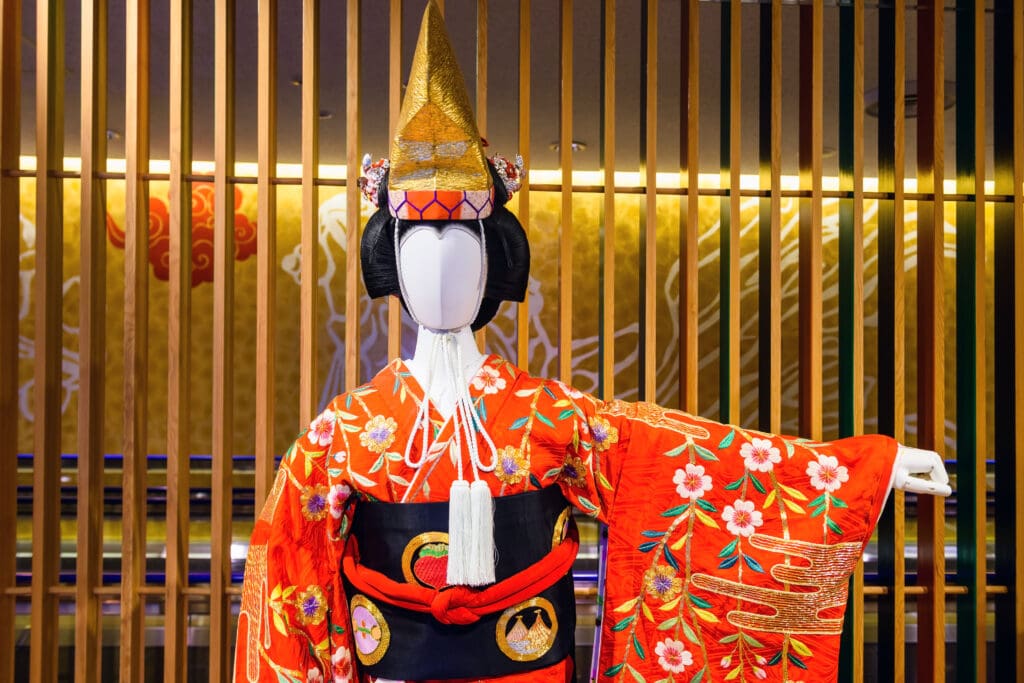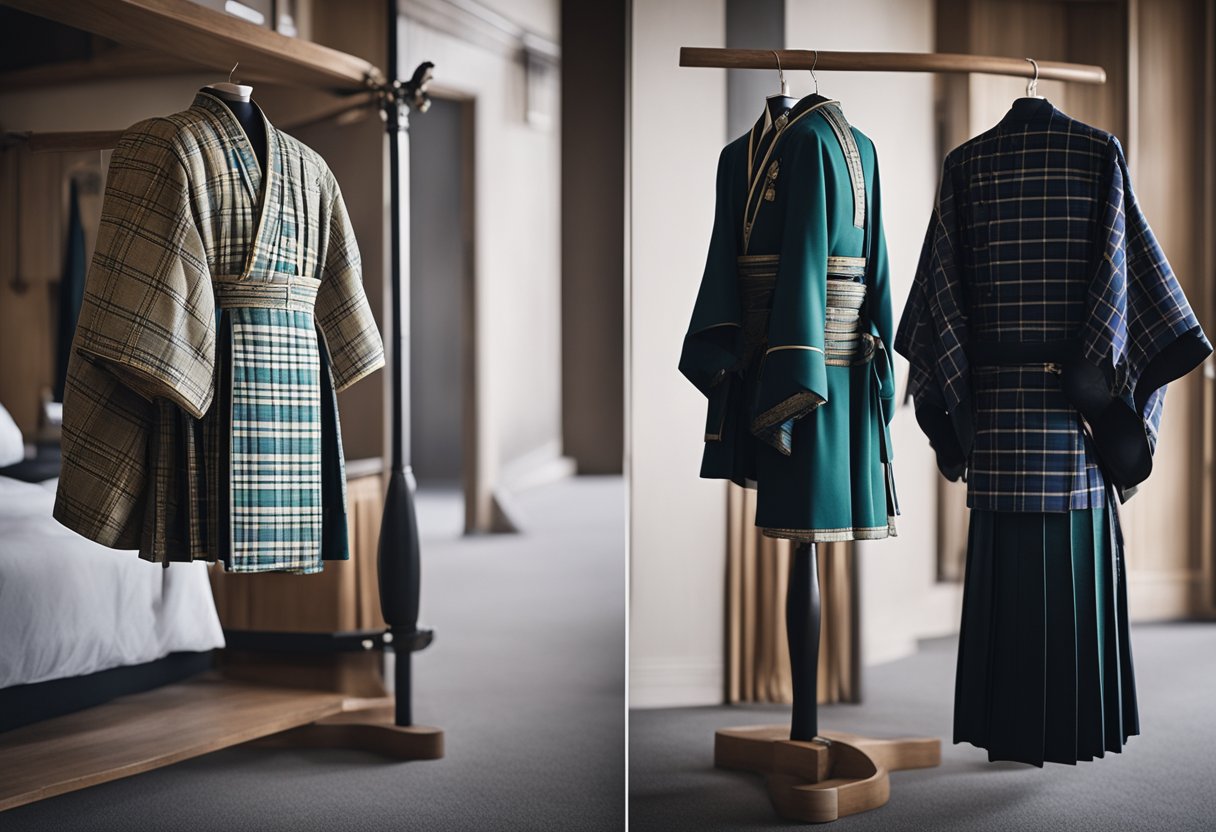The Evolution of Traditional Clothing: Tracing the Journey of Kilts and Kimonos

Updated On: April 24, 2024 by Raghda Elsabbagh
Traditional clothing has long been emblematic of cultural identity and social status. From the intricately layered Japanese kimono to the Scottish kilt, which carries the legacy of Gaelic warriors, traditional clothing has woven the fabric of heritage into everyday life. Each piece is a testament to the evolution and enduring significance of fashion and serves as a living diary, charting sociopolitical changes, technological advancements, and aesthetic shifts over time.

As we explore the history and transformation of these iconic garments, we witness not only a change in style but also in meaning. Fabrics and materials that were once exclusive to the upper echelons of society have transitioned over time, with modern interpretations often reflecting a balance between accessibility and respect for time-honoured customs. The journey from functional attire to modern-day cultural symbols tells a vivid tale of ingenuity and adaptation, providing insights into the societies from which they originated.
Table of Contents
The Historical Significance of Traditional Attire
In exploring the evolution of traditional clothing, we find that garments like kilts and kimonos aren’t just fashion items—they embody the tapestry of our past. These clothes offer insights into our cultural heritage and historical experiences, revealing much about who we were and how we lived.
Cultural Heritage and Identity
Kilts, originating from the Scottish Highlands, have long been a profound symbol of national identity and cultural heritage. This garment, believed to have begun forming into what we recognise today during the 16th or 17th century, traditionally indicated clan affiliations. Each clan’s unique tartan pattern served as a visual signature, linking individuals to their family lineage and regional identity.
Kimonos’ elegance, often seen as the epitome of Japanese attire, carries an equally rich heritage closely tied to social structures and customs. These garments have been crucial in ceremonies and festivals, epitomising social status and respect for tradition.
Clothing as Historical Documentation
Traditional attire functions as a living record, documenting pivotal moments in history. For instance, the enactment of the Dress Act of 1746, which prohibited wearing the kilt, marked an attempt to suppress the Highland culture. The subsequent repeal of the act became a significant event, highlighting the resilience of cultural expressions against political efforts to dull them.
In the same vein, the intricacies of kimonos—such as fabric choice, colour, and pattern—serve to chronicle the wearer’s status and the era’s customs. The transformable nature of kimonos, embracing new influences while maintaining traditional elements, reflects the dynamic story of Japan’s history.
Through our attire, we carry forward our ancestors’ legacy, honouring and preserving the rich tapestry of our collective past. Each stitch and fold contains stories waiting to be rediscovered and cherished anew.
Exploring the Kimono: Japan’s Iconic Garment
The kimono stands as a celebrated symbol of Japanese culture, reflecting an elaborate history, meaningful designs, remarkable fabrics, and its versatile presence in modern fashion.
Evolution from Heian to Edo
The kimono, once known as a kosode during the Heian period, transformed over time. It featured broad sleeves and was typically layered. During the Edo period, it evolved into an outer garment for any gender, streamlining into the shape we recognise today.
Kimono Designs and Symbolism
Intricate designs on kimonos are replete with symbolism. Patterns often convey seasonal themes or good fortune. Colours are chosen with purpose; for example, a deep red may be worn for celebrations. An obi, the sash worn around the waist, adds both aesthetic and symbolic value.
Materials and Patterns
Silks are the most coveted materials for kimonos, while cotton and linen are used for casual wear like yukatas. Patterns range from simple geometric repetitions to elaborate scenes embodying various aspects of Japanese culture, from cherry blossoms to kabuki motifs.
Kimono in Modern Fashion
Our current fashion landscape sees the kimono mingled with contemporary styles. Designers infuse elements of the traditional garment into modern clothing, while accessories like zori and geta maintain their authentic appeal. The kimono demonstrates how traditional Japanese garments can inspire current trends.
The Scottish Kilt: A Symbol of Cultural Pride
The Scottish kilt stands as a powerful emblem of Scottish culture and national identity, celebrated for its heritage and worn with pride in Scotland and around the world.
History and Evolution of the Kilt
Originally, the kilt began as the “great kilt,” a full-body garment that wrapped around the wearer. It evolved into the modern kilt, known for its distinct tartan patterns representing Scottish clans. Kilts were historically made from wool, serving both practical and symbolic purposes in Scottish heritage. The history of Scottish kilts shows that it was confined to the Highlands, becoming a symbol of Highland culture that was distinct from the Lowlands.
Design Elements of Kilts
Kilts are defined by their tartan patterns, the setts chosen by specific clans or traditions. They are traditionally made from woven wool and consist of a pleated skirt with a flat front panel. The design includes a sporran, a decorative pouch, and often is accompanied by a bespoke jacket and shirt, suited for formal occasions.
Kilts in Contemporary Fashion
Today, kilts continue to be a significant part of Scottish fashion, with designs ranging from traditional wool garments to modern kilt variations using various materials. This enduring appeal sees kilts worn at weddings, military events, and casual settings, reflecting an evolving yet respectful take on a historical garment. The contemporary use of kilts highlights their versatility and the retained pride in Scottish national identity.
Fabric and Materiality in Traditional Clothing
Traditional dresses across cultures have long been defined by the fabrics they incorporate. From the plush feel of silk to the durable touch of hemp, the material choice is both an aesthetic and functional decision.
Natural vs Synthetic Fabrics
The dichotomy between natural and synthetic fabrics has shaped the evolution of traditional attire. Natural fabrics like silk, cotton, and linen have been favoured for their breathability, comfort, and rich texture. Particularly, silk, with its lustrous sheen and smooth hand, has been the centrepiece in the crafting of Japanese kimonos, while cotton is a staple for its versatility and coolness in many cultural garments. On the other hand, the advent of synthetic fabrics offers a range of colours and durability not always possible with natural materials. These man-made fabrics have introduced an element of practicality to traditional wear, although they often cannot match the tactile quality of their natural counterparts.
The Art of Textile Making
Our appreciation for traditional dresses extends beyond mere aesthetics to the intricate art of textile making. This time-honoured craft involves transforming raw materials into beautiful, finished fabrics. We regard the process of dyeing fabrics to achieve vibrant colours or the hand-weaving of linen and hemp as testaments to cultural craftsmanship. Whether it is the delicate weaving of silk threads for a kimono or the spinning of cotton to create the resilient yet soft fabric for a kilt, we acknowledge the skill and dedication that is woven into every thread.
The Role of Traditional Clothing in Social Status

In the realm of traditional attire, clothing serves as more than mere protection or decoration; it’s a symbol of one’s place within the societal hierarchy.
From Everyday Wear to Formal Attire
Traditional garments, such as kilts and kimonos, have transitioned from everyday clothing to reserved pieces for special occasions like weddings and other formal events. The kilt, a fashion item rooted in Scottish heritage, has particularly seen such evolution. Initially serving as practical attire, the kilt has come to signify formality and social status. Only certain patterns or tartans, once indicative of clan identity, are now often chosen to represent connections with prestigious families or institutions.
Clothing and the Elite
High-quality materials and intricate designs in clothing have long been a marker of the elite. For instance, in Japan, the kimono is deeply intertwined with social status, with different styles and fabrics indicating one’s rank and wealth. The opulent fabrics and elaborate patterns are usually reserved for those of high status, particularly during formal events. In Scotland, wearing a full kilt ensemble, complete with accessories that denote lineage, can imply one’s prestigious status or association with elite groups.
Dyeing Techniques and Colour Trends Over Time
In examining the evolution of traditional garments like kilts and kimonos, we observe a vibrant history of dyeing techniques and colour trends that mirror cultural shifts and technological advancements.
Traditional Dyeing Methods
Long before the explosion of colour choices in modern fashion, our ancestors used natural sources to dye fabrics. They employed a range of techniques that depended on the availability of local plants, minerals, and animals. In Scotland, the distinctive plaids of kilts were often coloured with dyes made from native plants like heather, bracken, and blueberries. Japanese kimono makers, on the other hand, perfected the art of using substances like indigo and persimmons to create a rich palette of hues. The mordanting process, known for centuries, was crucial to improving dye absorption and the fastness of colours, especially for fabrics like cotton.
In both cultures, the sleeves and body of the garments showcased the versatility of natural dyes, with each region developing its own palette and dyeing methods that contributed to the identity of their wear.
The Shift to Colourful Apparel
As centuries passed, society’s desire for colourful apparel grew, and with it, the methods of applying colour to fabric evolved. The Industrial Revolution introduced synthetic dyes, allowing for a broader spectrum of vibrant and consistent colours. This led to a noticeable shift in the colour trends of clothing across the world. Even traditional wear, such as kilts and kimonos, began to incorporate these new, vivid colour options, reflecting a blend of tradition and modernity.
This era brought an unprecedented level of vividity and consistency to fabric colours. Patterns and designs that were once limited by the vagaries of natural dyeing could now be repeated with precision. This not only transformed the look of traditional attire but also the cultural perception of colour and fashion.
Patterns, Embellishment, and Artistry

We see a deep connection between the clothing patterns, embellishment techniques, and artistry that were traditionally employed across various cultures. The work of skilled artisans shines through in the intricate designs and symbolic motifs that often carry significant cultural meaning.
Craftsmanship and Design
The construction of traditional clothing, such as kilts and kimonos, underscores the meticulous craftsmanship and design expertise passed down through generations. Scottish kilts, for example, typically comprise a tartan pattern, where each colour and stripe sequence is significant to the clan it represents. In Japan, the technique of creating intricate patterns on kimonos involves various textile arts like Shibori (tie-dyeing), which was historically used for court costumes as early as the 10th century, hinting at a long-standing tradition of fabric design in Kyoto. The kimono’s shape, cut from silk using the straight-line-cut method, has remained unchanged for centuries, showcasing the timeless nature of its design.
Iconic Motifs and Their Meanings
Each traditional garment often bears iconic motifs that are rich in symbolism. The careful placement of these motifs can communicate status, personal identity, or social affiliations. For instance, certain patterns on kimonos imply specific meanings: cranes can represent longevity, while cherry blossoms might symbolise the transient nature of life. Similarly, the various colours used in kilt tartans have deep symbolic meanings ranging from red, indicating bravery, to green, which symbolises the love of nature. These elements of design not only add visual appeal but also convey a language of their own, where meaning is woven into the very fabric of the garments.
Adaptation and Modernisation of Timeless Styles

As we observe the transformation of traditional attire, it becomes evident that the influence of Western fashion and the ingenuity of contemporary designers play pivotal roles in redefining heritage pieces for modern times.
Influence of Western Fashion
The incorporation of Western clothing styles into traditional garments has been a significant aspect of their evolution. For example, the Meiji era marked a distinctive shift in Japanese fashion, where kimonos adjusted to Western standards after Japan’s increased trade with the West. Elements of Western attire were woven into the fabric of Japanese clothing, reshaping the style and even leading to the decline of men wearing kimonos. Similarly, in the case of the Scottish kilt, contemporary designs have been influenced by Western attire while retaining their unique cultural essence. The modern kilt maintains its traditional appeal yet often incorporates modern materials and motifs, reflecting a fusion of cultural respect and present-day practicalities.
Contemporary Designers Redefining Tradition
Contemporary designers are at the forefront of bringing innovation while honouring the spirit of time-honoured styles. These creatives are not just fashion enthusiasts; they are catalysts for change in the way we approach traditional clothing. Designers have introduced ready-to-wear kimonos with modern materials, making them more accessible and reflecting a more Western way of life. In the realm of kilts, designers are pushing the boundaries of the iconic silhouette, offering variations that are comfortable, versatile, and suitable for a wide range of occasions, from formal events to casual outings.
By embracing the principles of adaptation and modernisation, traditional styles continue to evolve, ensuring they remain beloved and relevant in our diverse, ever-changing fashion landscape.
Functional Aspects of Traditional Dressing

In exploring the practical roles of traditional clothing, we uncover how garments have been tailored for various occasions and their capacity to endure through time and trends.
Garments for Different Occasions
From the Scottish Highlands to the tea houses of Japan, traditional attire plays a pivotal role in ceremonies and daily life. A kilt, with its tartan patterns, signifies clan lineage and is often reserved for weddings and significant cultural festivals. Each tartan is historically poignant, encompassing a sense of identity and belonging. In Japan, the kimono is selected with great care for events such as weddings, but also for formal occasions like tea ceremonies, with specific styles suited to each event.
Adaptability and Longevity
The versatility of traditional garments is central to their longevity. Kilts, for instance, have transgressed their ceremonial use to become a symbol of Scottish pride in everyday wear. The adaptability of the kilt has ensured its survival, even in modern wardrobes. Similarly, kimonos have maintained their relevance through their capacity to be re-worn and passed down generations. They are constructed with the straight-line-cut method, which not only allows for repair and size adjustment but also recasting into other garments like children’s wear, contributing to their sustainability and longevity.
Cultural Events and Traditional Attire
Traditional attire stands out as a profound expression of heritage and identity when we consider the tapestry of international cultural events. Garments like kilts and kimonos are not merely clothing; they embody the stories and customs of generations.
Festivals and Celebrations
At cultural festivals and weddings, attire is often bright, elaborate, and symbolic. In Scotland, kilts are a quintessential component of men’s attire at Highland Games and weddings, representing clan allegiances and personal heritage. The Evolution of the Kilt has seen this garment remain a vital part of Scottish identity despite changing fashions over centuries.
In Japanese dress at traditional festivals like Tanabata, you’ll often see the customary yukata, which is a casual summer kimono. However, more formal occasions, such as tea ceremonies, call for full kimonos, highlighting the intersection of traditional Japanese culture and meticulous ceremonial clothing etiquette.
Ceremonial Clothing and Etiquette
Ceremonial clothing often adheres to strict etiquette, reflecting the importance and solemnity of the occasion. For instance, in Japanese funerals, traditional attire is expected, with men and women wearing subdued kimonos to pay their respects. Traditional Japanese culture holds these conventions in high regard, ensuring that each garment and its presentation honours tradition.
In contrast, the attire for a Scottish wedding might include a kilt made of tartan associated with the groom’s family, worn with pride and respect for one’s ancestry. This not only honours personal heritage but the broader cultural heritage of Scotland.
In our role as chroniclers of cultural expressions, we witness how traditional attire enriches these events, adding layers of meaning and beauty to life’s key moments.
Traditional Clothing in the 21st Century
In the 21st century, traditional clothing has seen a dynamic evolution, blending heritage with contemporary style and fashion to stay relevant in today’s global market.
Heritage Brands and Market Evolution
We’ve witnessed heritage brands revitalising the market by infusing traditional garments with new life. These labels have sustained national identity while adapting to modern trends. In Scotland, for example, the kilt has transitioned from a symbol of Highlanders and special occasions to a stylish item of everyday wear. It’s a striking example of how wool and patterns associated with the elite maintain prominence yet fit seamlessly into current fashions. The kilt’s relevance, bolstered by its historical significance, showcases the successful market evolution of traditional attire.
The Globalisation of National Dresses
Similarly, the globalisation of clothing typically connected to national dresses has made the likes of kimonos and other cultural garments common appearances on the global fashion stage. From the Kamakura to the Meiji periods, kimonos were crafted from silk and cotton, and wearing one was often associated with good fortune. Today, these pieces are reinterpreted as high-fashion statements or blended into daily wear, both within and beyond their countries of origin. Embracing a single piece of cloth design ethos, modern adaptations respect the past while inviting new audiences to experience and appreciate these enduring symbols of heritage.
Frequently Asked Questions
In this section, we address some of the most common inquiries regarding the rich history and evolution of traditional clothing, specifically focusing on the development of the kimono in Japanese culture, the evolution of the kilt within Scottish tradition, and the origins and distinctions of these garments.
What is the history of the development of the kimono in Japanese culture?
The kimono has undergone significant transformation throughout Japanese history, originating as a simple garment for the elite and evolving to embrace more colourful designs and synthetic fabrics, though it has become less common in everyday wear.
How has the kilt evolved within Scottish tradition?
Within Scottish tradition, the kilt has transitioned from everyday use to a symbol of cultural heritage, with its design shifting from the practical belted plaid to the tailored garment recognised today.
What garments were traditionally worn in Scotland prior to the adoption of kilts?
Before the kilt’s adoption, the Scots traditionally wore the leine, a tunic-style garment, and the belted plaid, which later evolved into the modern kilt design.
Can you trace the geographical origins of the kimono?
The kimono traces its geographical origins to Japan, where it evolved from Chinese-inspired robes into the unique, culturally significant Japanese garment known today.
What led to the initial use of kilts among Scottish men?
Kilts were initially embraced by Scottish men for their versatility and suitability to the Highlands’ rugged terrain, providing warmth and ease of movement.
What differentiates a kimono from a yukata in a historical context?
Historically, a kimono is a formal garment often made from silk, whereas a yukata is a more casual cotton version, typically worn during summer festivals and events.






